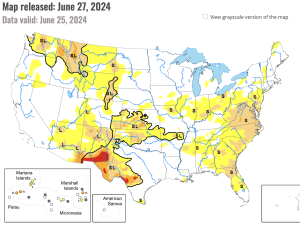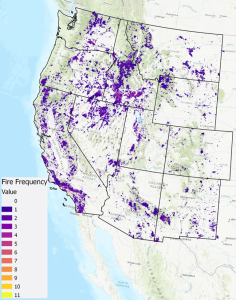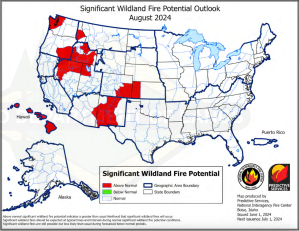Fire Season: What’s in Store for ‘24?
For most of Idaho, 2023 was one of the calmest fire seasons in decades. While we’re off to a slowish start in 2024, this summer’s blazes are expected to be more “normal.” That likely means smoky skies, canceled trips to the backcountry, and potential evacuations.Predicting fire seasons is always a gamble, but earlier this month the Boise-based National Interagency Fire Center gave it a go at a meeting of the Idaho Land Board.According to meteorologist Jim Wallman from the National Interagency Fire Center, current forecasts indicate that Idaho could see an “average to above average fire season.”  Mr. Wallman noted that warmer temperatures are expected this summer before a transition to a La Nina weather pattern sets in sometime late this year, which suggests steadier precipitation (that’s good news for skiers).
Mr. Wallman noted that warmer temperatures are expected this summer before a transition to a La Nina weather pattern sets in sometime late this year, which suggests steadier precipitation (that’s good news for skiers).
But what does a “normal” fire season even mean?
With rising temperatures and increasingly inconsistent precipitation, there’s a new normal for fire season in Idaho. While last year may have offered a reprieve, over the past several decades fire seasons in Idaho have gotten longer, more intense, and more resistant to control. In some parts of the West, research has shown that fire seasons last longer, an average of 40-80 more days than it did in the past! That means more resources are needed by the primary firefighting agencies in Idaho, which include the Forest Service, Bureau of Land Management, and the Idaho Department of Lands (IDL). The good news is we’ve seen significantly increased federal and state funding for wildfire capacity, but the bad news is the State of Idaho has struggled to hire the firefighters they need since they don’t pay wildland firefighters as much as federal agencies (which also pay bonuses in some instances).According to the Idaho State Forester, several Engine Foreman positions remain unfilled. If there are no qualified staff to oversee an Engine Crew, that means that the crew can’t go out when there’s a fire. As a stopgap, IDL will call up foresters or other permanent staff who are qualified, but if they’re not available, the state will have to rely on federal or contract fire crews which are more costly.
Remember, Idaho’s landscapes need fire.
Idaho’s forests and rangelands have relied upon fire as an agent of change for millions of years. Some of our lower-elevation dry forests were adapted to frequent, low-intensity fires every 5-15 years. In wetter and higher-elevation forests, some historically burned at high intensity every 150-300 years. For forest ecosystems that can benefit from prescribed fires, climate change is continuing to shorten the burn window—making these necessary treatments more difficult to plan. Even on rangelands, the sage-steppe ecosystem were adapted to fires every 60-110 years, but the reality is invasive species (predominantly cheatgrass) and increased drought means that some areas in southern Idaho are now burning every 5 years. This increased fire recurrence means that longer lasting shrubs like sagebrush don’t have time to regenerate, shifting entire ecosystems from shrublands to grasslands. 
In the end, we know we’ll have fire.
We know that wildfires will break out in Idaho this summer, we just don’t know when and where. Because of the wet springs in 2023 and 2024, there is an abundance of grasses that can fuel rapid fire growth in southern Idaho. In the forests of North Idaho, the number of dry lightning storms and strong winds can spell the difference between a mild and severe fire season.Another factor that influences wildfire is the number of human starts. Last year Idaho saw twice as many human-caused fires as the year before (206 vs. 78). These are entirely preventable, and increased education and awareness play a key role. We know we’ll have fires, from human or natural causes, and because firefighters cannot stop all of them we need to increase efforts to make our homes more fire-resistant. For those who live in fire-prone areas of Idaho (Reality Check: that’s most of us!) there are simple steps we can take to reduce risk:
For those who live in fire-prone areas of Idaho (Reality Check: that’s most of us!) there are simple steps we can take to reduce risk:
- Cut and trim brush and vegetation within 100 feet of your home,
- Move firewood away from your home,
- Cover any exposed soffits, decks, or other gaps where embers can land,
- Use fire-resistant building materials for your roof, siding, and decks, and
- Keep gutters, siding, and landscaping free of pine needles, leaves, grasses, and other “fine fuels.”
Check out Firewise USA for more links and tips on creating a Firewise plan for your home or property. Even if you don’t live in a high-risk location, you can still do your part.
- Ensure campfires are fully extinguished (cool to the touch!),
- Follow fire restrictions and rules, and monitor fires that may impact your plans (Inciweb is the go-to source for US fire info and the Canadian website FireSmoke provides useful smoke forecasts that include the US),
- Practice vehicle safety and DO NOT park on dry grass,
- Check weather, fire warnings, and drought conditions before you go,
- DON’T LIGHT OFF aerial fireworks to celebrate Independence Day. Bottle rockets, roman candles, and other private aerial fireworks are illegal across Idaho, and all fireworks are banned on public lands,
Do your part to protect the public lands we know and love, as well as to safeguard our communities, natural resources, and firefighters!

